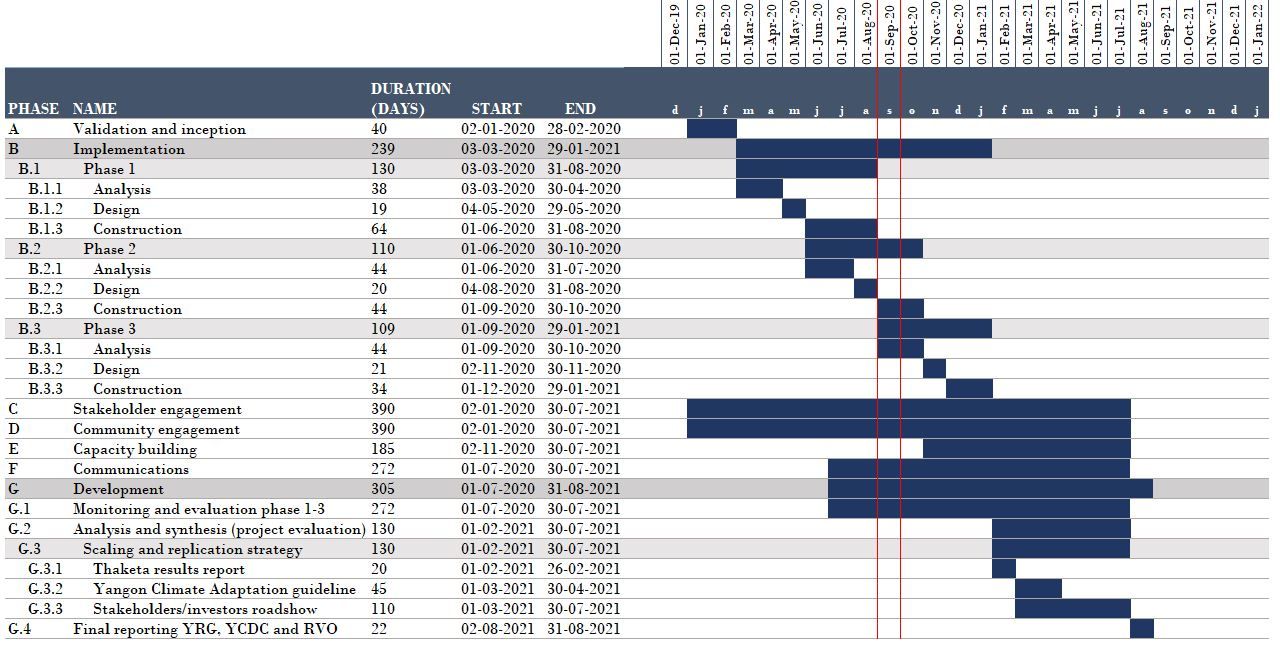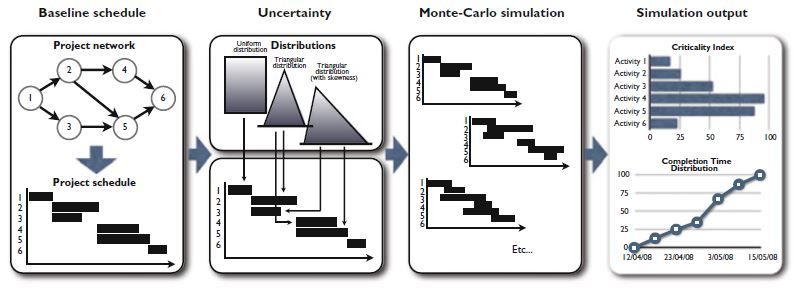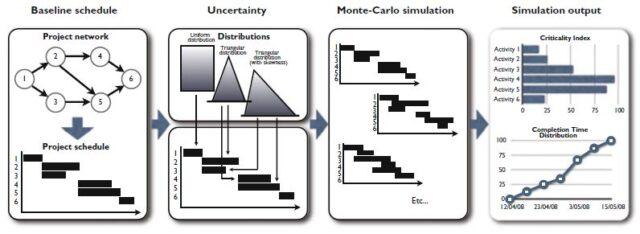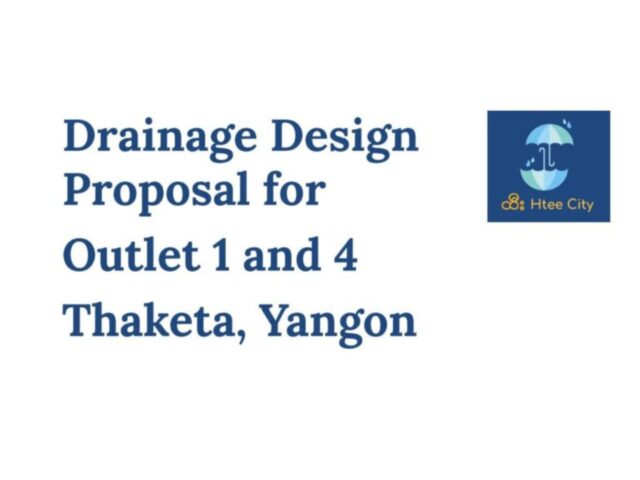What is risk management?
Risk management is important to know whether a project has the risk of being delayed. Identifying the risks of projects and their effects can help to manage the project properly and to mitigate these risks. A risk analysis was also done for the Thaketa Climate Resilience project. To get a better understanding of the risks and their impact on our project, Anouschka Stok did a research project on this. Below, a summary of this research is given, the full report can be found here.
Risk assessment: understanding the project, its activities and the stakeholders
The stakeholders involved in this project are The Water Agency, Infram, Resilience, Doh Eain, Witteveen + Bos, Water Bridge Myanmar, World Waternet and U.Minds. The risks of the project were first identified by the lead partner (The Water Agency), after the identification, all stakeholders filled out a survey to rank these risks. With the results of this survey it was possible to see how these risks affected the project. In total there were 41 risks identified. A timeline was made to indicate the activities of the project and the total duration of the project when risks are involved or when they are mitigated. The original timeline of the project is depicted in Figure 1.

.
This analysis was made with the assumptions of Vanhoucke and different steps. These steps are explained and depicted in Figure 2. First, a baseline schedule was made to identify all the activities and create a network diagram of the project. This network diagram is based on the schedule of Figure 1, it visualises the different connections between the activities. Secondly, the risks were identified with their probability distributions. Third, a Monte-Carlo simulation was created to get an overview of the duration of the project. Lastly, the simulation outputs were identified with their sensitivity indices.

In total 19 activities were identified during the project. These activities consisted of a validation and inception phase, three implementation phases (all including analysis, design and construction), stakeholder engagement, community engagement, capacity building, communications and a development phase (including monitoring and evaluation implementation phases, analysis and synthesis, scaling and replication, again consisting of three other phases, and the final reporting phase). For each phase the planned working days were included: these are the days which were planned by the stakeholders to complete an activity.
Almost all activities have a so-called ‘finish to start relationship’ (the next activity can start when the previous one is finished). There were 10 different paths in this project where activities were linked to each other by different relationships. The critical path is the path that will take the longest to complete.
Identifying and understanding possible risks within the project
Eight major risk categories were discussed in this analysis, in total there were 41 risks mentioned by the stakeholders. Each could affect the duration of the activities. With the help of a survey sent to the different stakeholders of the project, the distributions of both activities and risks were calculated, and each risk was assigned to certain activities. The variables (the minimum duration, maximum duration and most likely duration) of activities were first determined with the help of the survey, later these values were adjusted to values created by the Monte-Carlo simulation. Within these values, risks were included, and the simulation calculated the critical path of each simulation. From these values it is possible to see which activities have the most influence on the total duration of the project.
Understanding the possible impact of risks on the project
From the simulation model, the most realistic duration of the project would be 520 working days, the most optimistic duration would be 406 working days and the most pessimistic duration was simulated at 641 working days. The planned duration of the project in the beginning was 412 working days, which is significantly shorter than the indications of the simulation model.
It is important to know when a risk is mitigated, if it will decrease the duration of the project. Otherwise time and money is spent on the mitigation while it does not result in finishing the project in time. This is especially important as the difference between the variables of the simulation and the planned duration of the project is significant. Therefore, five scenarios were chosen to investigate and to mitigate specific risks. The scenarios chosen were based on the milestones that need to be reached during the project. Both the pessimistic duration and most expected duration do not reach any milestone and cause a delay of the project, therefore these two were chosen. The third scenario is about the optimistic duration: here the end date of the project is reached, but the milestones are again not reached, so mitigating risks in this scenario will indicate if the milestones could be accomplished. The fourth scenario was about preventing the most occurring risks, and the fifth scenario was about preventing the most common risks of the activities with the highest critical index value (the probability that an activity is critical).
Conclusions and how we used this analysis in the project
With the Monte-Carlo simulation five scenarios were investigated to see if the project could be finished in time and whether or not the designated activities could be executed before the milestones of the project. According to the simulation, none of the designated activities could be finished before the milestones. So none of the milestones are reached during the project. However, a more exact project duration is calculated, as the optimistic and pessimistic duration of the project are closer to each other. This helps to set a more narrow end date of the project as the durations do not deviate that much from each other.
During the Thaketa project, a Minecraft version of Ward 5 was created. With this model, several risks were mitigated, as implementations could be seen within the software and the residents of the Ward could be more included. Also, stakeholders could have a look within the Ward to see which implementations were implemented and how it would look. These are a few examples of how this software could positively influence the duration of the project. As a result, a lot of risks were mitigated with this software. During the Thaketa project there were also some complicated risks which could not be defined beforehand. At the start of the project, COVID-19 had not spread around the world yet. When this research was done, COVID was already there, but we did not know how severe it would become, so this is a risk which is really hard to include. Also, the military coup that took place on February first 2021 was not included within the risks.. As these are rare cases, these risks were not included in the risk analysis. The chance that one of these risks happened were so small that it was negligible, but however it did happen.
Overall, this risk analysis made the stakeholders realise which risks were linked to the project and to see how these risks influence the total duration of the project. A few interventions were implemented, so the most extreme risks were unlikely to happen. However, COVID-19 and the coup were not predicted as these are rare cases.





